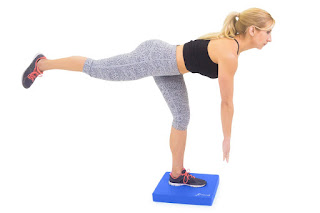WHY ARE BALANCE EXERCISES IMPORTANT?
Balancing is a fundamental aspect of any movement we perform. When standing on two feet, we're maintaining balance, even if we're not consciously aware of it. Watch a child learn to stand, and you'll realize that the act of balancing itself is the challenge—not the lack of leg or core strength.
When balancing, we're not only working the often-neglected stabilizer muscles; we're also improving our joint stability and internal focus.
Balance-focused activities will challenge our bodies' vestibular and musculoskeletal systems as well as our proprioception.
Balance is also one critical skill we tend to lose as we age, so maintaining it is crucial. It's a use-it-or-lose-it proposition.
THE BENEFITS OF BALANCE DRILLS
#1. REVERSING AGE-RELATED LOSS OF BALANCE
As we get older, our ability to balance declines. For instance, a critical predictor for longevity is the length of time that a person can stand on one leg.
Balancing is a complex skill that involves the brain, muscles, and parts of the inner ear. If you don't practice and maintain balance, the coordination between these three systems can deteriorate over time, making it harder for you to stay upright and maintain proper posture.
Practice, however, keeps everything working as if your body were much younger, helping you to stave off some of the balance issues that might accompany getting older.
#2. PREVENTING FALLS
Balance drills help you to control your core and limbs more deftly. Not only does this help improve the elegance with which you move, but it also helps you avoid falls. When you have good balance, you can more quickly adapt to changes in body position, adjusting on the fly to unexpected variations in elevation or rocks that you didn't see underfoot.
Avoiding falls not only helps you avoid physical damage like broken hips; it also boosts confidence. When you have good balance, you no longer have to worry about whether you might fall every time you leave the house. Even if you're young, having this unconscious awareness allows you to feel more confident in your environment.
When your balance system is working optimally, you can more quickly react to slips, making it less likely that you'll fall.
#3. BUILDING BETTER POSTURE
Thanks to poor movement form, a focus on a narrow range of movement patterns, and an ever-more-sedentary lifestyle, the average person has terrible posture. Many people develop limitations like hunched shoulders, anterior pelvic tilt, and reduced upper-back mobility. Part of the problem is that, as a population, we don't do the balance exercises necessary to counteract the adverse effects of our lifestyle.
Improving balance is excellent for posture. It teaches you the static and dynamic positions that are natural to your human form. Outstanding balance requires good posture: the two go hand-in-glove.
#4. ALLOWING FASTER RECOVERY FROM INJURY
Many people who train athletically suffer injuries, especially of the leg and ankle. Much of what is known about balance comes from research on people with lower-leg injuries. What that research shows is fascinating: the more balance drills people perform, the faster they recover from their injuries. Balance drills may also prevent injuries in the first place. [1,2]
#5. IMPROVING COORDINATION
Humans should have excellent coordination, just like other animals in their natural habitats. But, modern civilization prevents many of the physical tasks that we would have been forced to do in the past. This sedentary lifestyle means that we rarely have to practice balance. One effect of this development is our generally poor coordination.
Balance exercises, especially dynamic balance drills, like balance walking on railings, help to relegate balance to the category of reflexive response. Ultimately, with good balance, you should be able to intuitively adapt to practically any situation, without having to think about it.
#6. MAXIMIZING YOUR WORKOUT TIME
Most people doing weight training in the gym spend much of their time sitting around, doing nothing, while their muscles recover from the previous set.
If you're a busy person and want to use your time as efficiently as possible, then it's a good idea to find a way to capitalize on all that time between sets. Balance drills are an ideal use for those moments because they are low-intensity and do not interrupt muscle recovery.
#7. IMPROVING YOUR RUNNING TECHNIQUE
People with poor running technique can experience all manner of injuries, from shin splints to knee pain to hip problems. Poor form results from a lifetime of not having to run daily and not understanding the dynamic position of one's body. People with poor balance will often develop a sub-optimal gait to compensate.
Dynamic balance drills can help you to assess your center of gravity better unconsciously. Then, when you do go running, you'll feel more confident making more significant strides, opening up your hips, and turning your feet forward. With additional balance drills, you'll also learn how to swing your arms to counteract the rotation of your hips while striding, thereby reducing the strain on your core.
#8. INCREASING YOUR MUSCULAR POWER
Balance can strengthen your muscles, quickly increasing their power output. The more force they can exert, the faster you'll be able to sprint and the higher you'll be able to jump. Balance can help in practically any sport that requires short, sharp, and powerful movements, like boxing, and can help build all-around functional strength.

No comments:
Post a Comment